Remembering IRVING RAPPER
He directed some of the biggest stars of his era
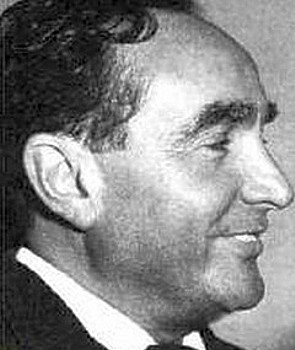
London-born Irving Rapper was beginning to forge a reputation directing for the Broadway stage when he took a chance on a whole new career and came out to Hollywood in 1936 to work for the Warner Bros. movie studio as a dialogue director.
It turned out to be a very wise roll of the dice for Rapper, who soon became one of the hottest young directors in Hollywood, working with the biggest stars, including the queen of the Warner lot--Bette Davis.
One hot summer day in July of 1980, I was invited to Rapper's dazzling all-white apartment on Franklin Avenue in Beverly Hills for an interview. Despite the heat wave, Rapper's butler served a formal English High Tea and for hours the director and I talked about his long and fabulous career.
Here are the highlights of that conversation:
BAWDEN: As I recall, your first big hit while you still were working as an assistant director was "The Charge of the Light Brigade" in 1936.
RAPPER: Right. Jack Warner (head of the studio) asked me, in a panic, to come onboard because (director) Mike Curtiz’s English was so bad he was afraid some Americanisms might slip into the script. Mike’s Hungarian accent got thicker with the years but his forte was composition of shots. The way he could move so quickly would be for a dialogue director to rehearse the cast in their dressing rooms as Mike was arranging the cameras and lighting on the stages.
With my British background I knew the movie story was bunk and most of it took place in India anyway. There have been historically expert remakes but they somehow lacked that zest that Mike instilled in his scenes. In fact he went too far at times and many horses had to be put down after breaking legs. There were wires placed among their legs so they’d fall on cue. This one was shot in six weeks because the actors were prepared and ready when Mike called. Jack Warner spent a fortune building the entire garrison town of Chukoti from scratch. One could see pieces of these buildings still up a decade later.
Errol Flynn was quite a character, came in late every day nursing a hangover. Ten years later his looks had wasted away. And who could have seen a decade later Livvie de Havilland would win two Oscars?
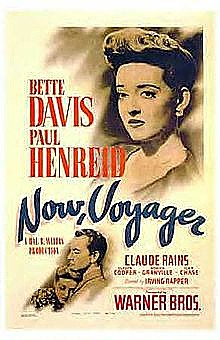
one of Rapper's most beloved films
BAWDEN: What other Curtiz epics did you work on?
RAPPER: "Kid Galahad" I remember. Eddie Robinson was always line perfect but one had to get him to modulate his performance. I became great buds with Bette Davis after that one. She trusted me. And when she got "The Private Lives of Elizabeth and Essex" I told her to ask for Curtiz, who she hated, instead of the assigned director, William Keighley, who was a bore. I said Mike would make it exciting and we’d work on interpretation in her dressing room. But at the last moment Jack sent me off to do "Juarez" and that was that. Bette hollered, but she was stuck with Mike, who still polished it all off in four weeks and a few days. Mike also used me in "Gold is Where You Find It" (1938) and "Daughters Courageous" (1939).
BAWDEN: You also did "Dark Victory: (1937) with Bette Davis.
RAPPER: Bette had a love-hate relationship with (the director) Teddy Goulding. He’d brushed out her hair and told her to use her natural color in "That Certain Woman" and thus began her rise to top stardom. This one was based on a failed Broadway play done by Bette’s nemesis, Tallulah Bankhead. Teddy introduced the character played by Gerry (Geraldine) Fitzgerald as Ann, her best friend, who could do all the mourning. Thus Judith (Davis' role) would never feel sorry for herself as in the play and it worked. In the dressing room I got Bette to wash out all emotion in the last scenes as Judith accepts her fate and can now do so calmly after experiencing true love.
BAWDEN: Another director who used you was William Dieterle.
RAPPER: Yes, but his English was much better than Mike’s. Bill truly looked the part of a director with his riding crop and tight leather boots. He liked to consult astrological charts to see how a scene should be played. An autocrat--but brilliant at shot compositions. The crowds really milled in his epics. He got me for "The Life of Emile Zola" (the 1937 Oscar winner for Best Picture), where a dialogue director was truly needed. Look at the crispness of those trial scenes and the actors constituted a who’s who of Hollywood character types. I enjoyed running lines with Louis Calhern, Grant Mitchell, Harry Davenport, Ralph Morgan, Henry O’Neill, Robert Warwick, Montague Love. I could go on and on. The uniforms cost a fortune to make. You know Bette begged Bill to use her in a star cameo in the picture as Nana and Paul Muni (the film's star) said no. He couldn’t stand (Bette) after her outbursts on the set of "Bordertown," so they used Erin O’Brien-Moore. That movie crackles during the verbal joust. It had to; there’s no standard movie action.
And Dieterle picked me again for "Juarez" (1939), which I felt was a big bore. Its box office failure heralded his decline at Warners, where he had once been ranked above Curtiz. Muni had a rubber mask inserted on part of his face. He felt an Indian would never betray emotions, but what was the public to think? But Bette in her brief bit as Empress Carlotta was really up for it, I felt she was the only reason for watching this film.
BAWDEN: Then there was Anatole Litvak?
RAPPER: With him I did the dialogue on "All This and Heaven Too" (1940) and "City For Conquest" (1940). He was quite the ladies’ man despite a tempestuous marriage to Miriam Hopkins. He had quite a fling with Bette Davis on the set of "All This and Heaven Too," which really stoked up her feud with Hopkins. But I also worked for Vincent Sherman ("Saturday’s Children") and Raoul Walsh ("High Sierra") and they spoke English just fine.
BAWDEN: How did you graduate to directing solo?
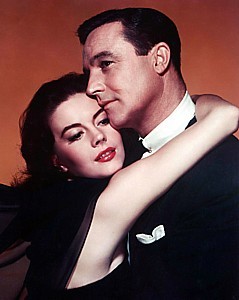
RAPPER: Jack Warner often offered me small pictures, but I declined. Once in the “B” unit I’d never get out. So, I just kept doing dialogue and waiting for my turn. Building up a substantial resume. Finally there was one I wanted to do: "Shining Victory." It was based on a rare play by A.J. Cronin all about a Scottish psychiatrist who falls for his assistant and the moral dilemmas he faces. Howard Koch and Ann Froelich did a screenplay that was devoid of the usual Hollywoodisms. Jack (Warner) said OK, but gave me a minimal budget and no stars. In the lead I had that wonderful English actor Jimmy Stephenson—he died later that year of a heart attack, just as he was about to reach stardom. I blame it on his compulsive smoking. As a good luck charm Bette Davis was unscripted as a nurse in one hospital scene. When Jack spotted her he blew a gasket, fearing she might claim it as one of the two films she was required to make that year. But Bette did it as a good luck charm for me. Gerry Fitzgerald was the lead, a great girl who never made it big in movies. She was stage trained. It made money, so Jack let me do another.
BAWDEN: Which was "One Foot in Heaven" (1941)?
RAPPER: The early Forties was a period of leave taking: Muni, Robinson, Cagney all departed and Jack tried short term deals to seal talent. He had Freddie March on a two-part deal and March selected this very downbeat story. Casey Robinson’s screenplay was pretty wonderful, based on Hartzell Spencer’s biography of her Methodist preacher father. It indeed was episodic rather than dramatic but Fred got to age and act all over the place. A whole wad of money went for the sets and the shoot was very leisurely for me—six weeks, I’m thinking. I loved my cast of Beulah Bondi, Martha Scott, Gene Lockhart. Robert Lord was the associate producer. Jack Warner saw it as a prestige item, but it did make money, which astonished him to no end. And he then gave me a big Barbara Stanwyck vehicle.
BAWDEN: That would be "The Gay Sisters" (1942)?
RAPPER: Yes and I got Barbara Stanwyck interested in it. She was back at WB for the first time in seven years (at $100,000 a picture) with script and director approval and this was supposed to be her big comeback. It was based on Stephen Longstreet’s faux Chekovian novel "The Gay Sisters." The title can be misinterpreted by today’s audiences. Missy (Stanwyck's nickname), Gerry Fitzgerald and Nancy Coleman were three sisters–get it?–but living in relative poverty in the family's Fifth Avenue mansion. George Brent was Missy’s husband, a grand friend but he had to be motivated or he’d just walk through a scene. I knew that from "Dark Victory." where his passivity roused the ire of Teddy Goulding. Barbara got too cynical for my liking and lost the movie audience’s sympathy, but this one did crackle with cruel lines. We thought we were being sophisticated but the public said thanks but no thanks.
By the way, there was a kid in it--Byron Barr--and he changed his name to the character he was playing here: Gig Young. I thought I’d then go on vacation but Mike Curtiz refused to do "Now, Voyager" (starring Bette Davis) and I got that. When Missy heard, she sent me a black wreath. Bette had this reputation of being impossible to work with by then.
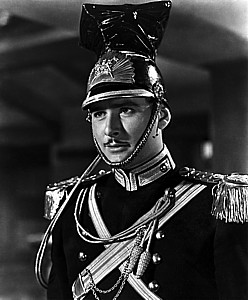
BAWDEN: But you got Bette onto "Now, Voyager.." Explain please.
RAPPER: Studio gossip said Hal Wallis had bought the novel for Irene Dunne and was about to sign her. I got one of the secretaries to slip me a mimeographed copy and gave it to Bette. She stormed into Jack’s office saying if he used her he wouldn’t have to pay Dunne’s $150,000 fee and Jack was ever the economy minded studio head. So Bette did it although Irene would have been fine. As the mother Hal Wallis suggested Dame May Whitty but she was too old. I suggested Gladys Cooper and Hal said, “Who the hell is she?” He’d never heard of her! I felt Gladys had to be the one because she could be very mean, I’d seen her on the stage. Finally, Hal gave in.
Bonita Granville and Ilka Chase were daughter and mother bitches who needled Bette’s character every chance they could. I didn’t want Paul Henreid, which is why he hates me today. I needed (Charles) Boyer, who wanted it with Dunne, but after one movie with Bette he passed, so I had to make do with Paul.
BAWDEN: What do you think of the reference to you at the AFI Tribute to Bette Davis last year?
RAPPER: Oh, that. Paul Henreid gets up and says he invented that famous business of lighting two cigarettes at the same time. He said a director he wouldn’t name tried to nix it and then says, “But Irving!” That brought loud belly laughs from Bette, who must have been drinking. In fact I stole it from a George-Brent-Ruth Chatterton film and when I asked George if I could swipe it he said, “Why not? I stole it from a silent movie I’d seen years ago.”
Bette was not temperamental during the shoot. She was frightened by Claude Rains and aimed to please him. Claude is the real ballast in that film. It works because Claude and Bette make you feel their intensity for each other. I told them I figured eventually Charlotte Vale would have settled down with Dr. Jaquith. But some of the set pieces were considered a bit silly even then. An intensity of acting skills carried the day.
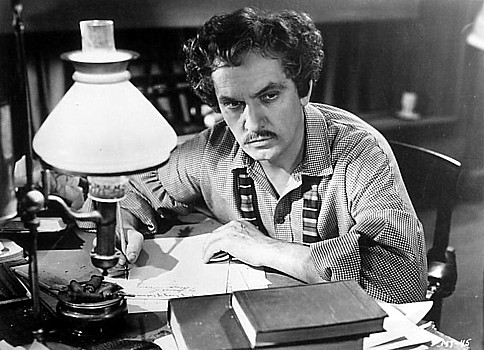
favorite among his movies, "The Adventures of Mark Twain."
BAWDEN: Next came your favorite film, "The Adventures of Mark Twain" (1944).
RAPPER: Again with Freddie (Fredric March). I couldn’t think of any other Hollywood actor who could do it and that includes Spencer Tracy. It came from the Harold Sherman play and the amount of money spent on decor and sets was truly huge. We had a two-month shoot, which was luxurious. Fred got better with this one as he aged. I told Alexis Smith she’d have to act in this one as his wife and she delivered. I had Donald Crisp, John Carradine, Sir C. Aubrey Smith--a dream cast. I like the scenes on the Mississippi best. It was a real labor of love. But so expensive to make it barely made back costs. Wartime audiences were not into such Americana. Compare it to other movies Warners was making at the time and it stands out.
BAWDEN: You were back with Bette Davis in "The Corn is Green"(1945).
RAPPER: Her name guaranteed it would be made. But I submit she was mightily miscast. I hated the decision to shoot even the interiors on sound stages. I’d seen the Emlyn Williams play with Ethel Barrymore on stage but she wasn’t a movie name. So Bette it had to be. The sociological trimmings if the play were shorn. We tested Bette heavily padded. She wanted a much younger interpretation. Bette had asked for me but there was a strain in our relationship. Carl Weyl did the sets, but the painted backdrops are too much. Of course, shooting on actual Welsh sets was impossible with the war still on. When George Cukor recently did that terrible TV version he actually went there and everything is just too green and sunny. Even Wales had changed in 50 years and no longer looked the same.
I chose John Dall and Joan Lorring as the kids. Poor Richard Waring was to do it. He was on stage with Ethel Barrymore. But then he got drafted. Dall never recovered from that burst of stardom. He was better in nasty parts, as in "Rope," and not conventional leads. He later committed suicide. The stress on actors is often deadly.
Because it was indoors and pre-rehearsed we shot the whole damned thing in a month. I thought it most odd Cukor asked me to a screening of his version. Bette and I did quarrel more on this one than before,She was getting too high handed. But the last time I talked to Bette ,I’d just seen the Cukor version and it was so poor I told her we had nothing to worry about.
BAWDEN: What did you think of "Rhapsody in Blue" (1945)?
RAPPER: Yipes! I begged Jack to hire Cary Grant as George Gershwin, but he said that would be too expensive. But, you see, George had no private life. He was a boring fellow outside of music. Then Jack turned around and hired Cary as Cole Porter in "Night and Day" and I had a choice dust up with him. He said no also to John Garfield. Finally, after much testing, he insisted we use a contract player, Robert Alda, who had the charisma of an amoeba. Look, I loved him in "Guys and Dolls," but not as Gershwin. Most of the story was fictional. I thought some of the Sonya Levien story completely absurd. Oscar Levant supplied quips as he went along. Alexis Smith and Joan Leslie played two fictional beauties. I had much trouble with Joan. She usually played teen-aged nuisances. Al Jolson was himself. That was for real. Some of the numbers like "Fascinatin’ Rhythm" and the actual rhapsody were passable. And yet it was a fairish hit. But after watching this one come into being ,Jolson refused Jack’s overture and sold his own life story to Columbia, where he had never worked.
BAWDEN: Was it an accident that the three stars of "Now, Voyager" were reunited in "Deception" (1946)?
RAPPER: Yes and no. Warners never had the policy that MGM had of doing sequels and having teams like (William) Powell and (Myrna) Loy. Yeah, I know Flynn and de Havilland--but that was the exception. Nobody ever thought of a sequel to "The Maltese Falcon," which seems crazy, doesn’t it? And I’d devised "Deception" from the start as a brittle, sophisticated comedy. It was based on an old Broadway play with Fay Bainter that was a “twofer”–only two characters ever appeared. Paul Henreid’s character of the returning husband never returned on stage. He was only discussed. But Jack thought about it and said, “We can re-unite the 'Now, Voyager' team" and that’s how he sold it to the public. It certainly was not realistic. Look at that huge loft Bette lives in and she’s supposed to be a struggling pianist. Claude Rains understood all this and seized the occasion. In one scene we come upon Claude reading the Sunday funnies in his bed. Then there’s the scene where he orders dinner for everybody and goes on and on about preparations and sauces and wines.
But Bette attacked it as melodrama. I’d already warned her it was Claude’s picture. She stormed around. In the morning I’d hear her high heels clacking along on the concrete floor and knew it would be a rocky day. On other days she’d tip-toe around in ballet shoes and I knew I had the compliant Bette. The more we got into it the more she became dissatisfied. Finally, she stormed in to Jack and said she had to kill Claude at the end because he was stealing the picture. Jack agreed ‘cause he loved the obvious. Claude went along because he could manage a death scene (on the stairs) that really upstaged her. My preferred ending had the threesome–and this was a menage a trois plot–strolling hand in hand right into the camera and laughing. Bette, you see, was pregnant by then and showing. So she started berating cinematographer Ernie Haller, who, after all, had done a lot of "Gone With the Wind," asking him to make her as young as she’d been in "Jezebel."
“But, Bette, that was eight years and a lot of cigarettes ago,” he said.
His deep focus photography and Claude’s close to the top performance saved the day. The film was very bewildering to most postwar audiences, I imagine.
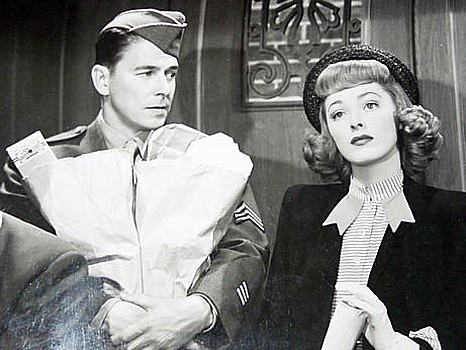
a film Rapper wasn't too happy with when it was finally finished.
BAWDEN: You’ve already said you don’t much like your version of "Voice of the Turtle" (1947)?
RAPPER: I hate it! Too much tinkering can kill a play. It was changed quite a bit to pacify the censors. A lot of the sexual tension was cut out. It’s funny, but it seemed dirtier this way with the teasing instead of the actual play version. We shot exteriors for a week in New York and the rest was back lot stuff. I guess it’s OK if you didn’t see the play. But I was so angry at studio interference I decided to freelance. So I was unemployed for the next two years as movie production declined. I blame it all on my agent. I could have signed for another seven years at Warners and I blew it.
On the stage, I adored Margaret Sullavan and Elliot Nugent. But Jack ordered it opened up. Sullavan refused to sign a long term deal, so Jack replaced her with Eleanor Parker, who had never done comedy. Ronald Reagan was just plain dumb as the soldier. He just didn’t click with Ellie and mugged furiously. Ron came in every day with suggested bits of business to lengthen his part! Jack was trying to promote him as the next big male star on the lot--only it didn’t happen. Eve Arden effortlessly stole ever scene she was in.
BAWDEN: What was your next film?
RAPPER: "Anna Lucasta" (1949) at Columbia two years later. Movie companies were pruning their lists. It was the best I could get. I get there and (studio boss) Harry Cohn says he’s ordered a switch of races! “I got rid of the Negroes,” he chuckled. “Now it’s Polacks!” I’m directly quoting him. We had to use Paulette Goddard, who was 44 and looked it. She even wanted a bathtub scene which she said was her speciality! I really wanted Susan Hayward, who was available, but Paulette said she’d sue. This was very hard going because Paulette could never match her bits of business from long shots to close ups. Not that I didn’t admire her. She was a true Hollywood courtesan. Up in her apartment it was filled with expensive paintings. She took off her bracelet and tossed it in a drawer overflowing with real jewelry…she had cases of the stuff from admirers. Very sophisticated in real life but on set she just froze up. And the film tanked, hastening Paulette’s (demise) as a Top A star.
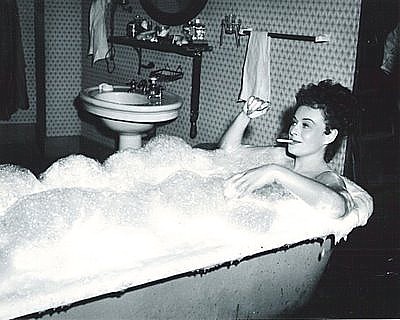
Lucasta." Rapper described Goddard as "a courtesan."
BAWDEN: How did you get back to Warners so fast?
RAPPER: Jack Warner just wasn’t at all sure about "The Glass Menagerie" (1950) . True, he’d bought it for Jane Wyman, who had just won the Oscar. But she was 36. I told him only Bette Davis could play the mother, Amanda, but Jack pounded the table in rage and said he wouldn’t have her back at the studio. So, he ordered me to go to New York and “screen test all the old broads”. I tested Talullah Bankhead for three days and she was magnificent. Then, on day three, she went on a drunken spree and one of Jack’s spies told him about it and he banned her. Miriam Hopkins was also on Jack’s banned list. I interviewed Ruth Chatterton in a hotel lobby, She had a thick veil and refused to let me see her face. Ethel Barrymore simply told me she thought she was too old–and she was right.
I have always felt Gertie Lawrence didn’t understand the part. She spent most of the film looking dazed. She cried a lot in her dressing room, too. She demanded a flashback scene, so audiences could see her in her prime and not this washed out old thing. Tennessee Williams was around during shooting and rewrote the story to open it out, which I felt was a mistake. Jane tried her best. That wig was awful, wasn’t it? She gave as good an interpretation as any Hollywood actress could do. Arthur Kennedy as the son excelled and Kirk Douglas was very vulnerable as the gentleman caller. It made a small profit based on Jane’s name.
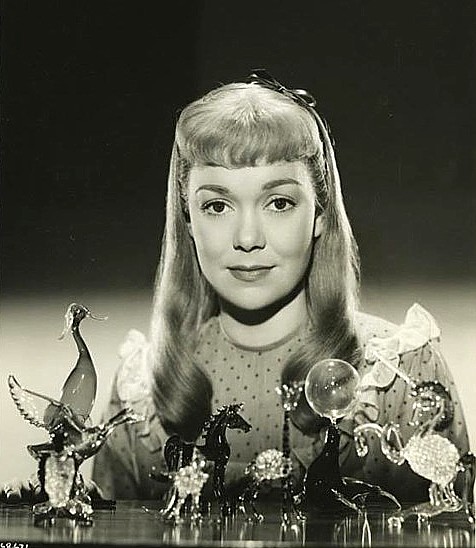
"The Glass Menagerie."
BAWDEN: At Paramount, you did a "Sunset Boulevard" type story, "Forever Female" (1953)?
RAPPER: Not at all. It was set on Broadway and had Ginger Rogers as an ageing stage star who must realize she can’t play the ingenue any more. Paramount had a batch of J.M. Barrie plays and was remaking them. They’d had some success with "Darling, How Could You?" with Joan Fontaine. This one came from Barrie’s "Rosalind." It was essentially light, frothy, and it captured the Broadway atmosphere quite well. But there was great tension on the set. Bill Holden did not want to take second billing to Ginger, for one thing. Then he won an Oscar for "Stalag 17" and didn’t ever have to again. Paul Douglas was Ginger’s husband, a good part for him. The pert and sassy ingenue was Pat Crowley, who Paramount thought would be the big new star. It never happened, but she’s still at it. Her best bud was Marion Ross, now the mom on "Happy Days." I had a good cast: Marjorie Rambeau. George Reeves, King Donovan. I thought it worked on a certain level. But there was tension on the set. Ging had just taken as her third--or was it fourth--husband, Jacques Bergerac. She was 42, he was 28. Bill and Paul ribbed her incessantly and her facade cracked and she really got vicious. And, after all,Bill was an inveterate skirt chaser and Paul had been married multiple times. But you never see that animosity in the finished product.
BAWDEN: Didn’t you also make "Bad For Each Other" (1953) for Paramount?
RAPPER: Yes and on the Paramount lot. Then the producer Hal Wallis strolls on set right at the end of filming and calls me over and says, “Irving, I’ve sold the whole thing to Columbia.” I was stunned, but Paramount was in financial troubles and needed dough quickly. And Harry Cohn needed product so he bought the negative and when released it made a fair profit for him. I still think it’s a dandy soap. Charlton Heston is a doctor back from Korea and intending to practice in his Pennsylvania mining town. Lizabeth Scott was his self centered wife who wanted the finer things. She was terrific, I thought. She told me this was where she was from, Scranton. Charlton was in his broody period. He’s a very serious guy. I cast Arthur Franz as a young idealist. And I got Marjorie Rambeau back as a shut in to add some pep to scenes. Also around were Ray Collins and Millie Dunnock. It’s a good character study, not a great one by any means. And the black and white on location cinematography is pretty fine.
BAWDEN: What do you make of "Another Man’s Poison" (1951)?
RAPPER: It was tosh. Based on a thriller by Leslie Sands. Worked well on the stage. But not here. I designed it as Barbara Stanwyck’s first European made movie. But Stanwyck then found out her husband, Bob Taylor, was fiddling around in Rome and, distraught, she returned to L.A. and refused to proceed. So I got Bette on the rebound. She needed to work and insisted her husband, Gary Merrill, be included. I’m not a big Gary Merrill fan. He was a supporting actor. And I added Emlym Williams, who’d created "The Corn is Green," as the very strange neighbor. It was all so precious. When Bette is trapped in a tight corner, she over-acts wildly. And, boy, did she go over the top here. She really was still playing Margo (Her character in "All About Eve"). The public was indifferent. Her salad days as a big star were over and the rest of the decade was a drought for her.
BAWDEN: Why make a movie like "Strange Intruder" (1956)?
RAPPER: Because I wanted to work with Edmund Purdom? I’m only teasing you. I needed the work. The script was loopy, but with Ida Lupino, I figured we could do something. I can’t bear to watch this one. It just didn’t work. I tried to cover up the plot holes with neat touches but nobody, thankfully, saw it and I just went on to my next movie.
BAWDEN: Which was "The Brave One" (1956)?
RAPPER: The story was wonderful and Dalton Trumbo wrote a delightful screenplay –or should I say Robert Rich (Trumbo's pseudonym), because he got an Oscar and thus the blacklist was stormed. I needed a beautiful young boy who looked Mexican and this darling boy Michel Ray came into my office in Paris and he sort of interviewed me. He had a Brazilian father and certainly looked the part. The bull scenes are the highlights and the intense friendship between the boy and the bull. Hardest scene to shoot was the bull going after the leopard, who is threatening the bull. It took days to set up and execute. I’ve been told it’s a classic. People remember seeing it when they were young. Michel was some actor, but after "Lawrence of Arabia," he retired to devote time to his studies. He had high academic honors at Harvard University, married into one of the highest British families (they own Heineken beer) and today is very wealthy and contented. And I wonder if he ever thinks about those months when his best friend was a bull?
BAWDEN: You went back to WB for "Marjorie Morningstar" (1958).
RAPPER: And Natalie Wood still phones me to this day. That’s the kind of special person she was and is. She really grew up in the business, but, unlike most child stars, she never turned crazy. Actually, it was made for United States Pictures and Milton Sperling was the producer, releasing through WB. Jack Warner really wanted Danny Kaye for the lead of Noel Airman, but Danny said the book was anti-Semitic and passed. Jack ordered the Jewish theme airbrushed out so the story often makes no sense. He said to cast Aryans in the Jewish roles. I still find Gene Kelly pretty fine because he was playing a rather untalented producer and Gene exudes talent. Natalie was just at the cusp of super stardom. She was a hard worker and she got into the role the more she did it. We did a lot of it on location at Scroon Lake in upper state New York. Claire Trevor went way over the top as the overly protective mother. Harry Stradling shot it beautifully and it was a hit because of Nat.
BAWDEN: Then came "The Miracle" (1959).
RAPPER: I needed a miracle to pull this one off. How long did it take me to make this one? Oh, 21 years give or take a year. Bette Davis first did a screen test with me coaching her in 1938-39, but Jack wouldn’t budge. However, he did have "The Nun’s Story" in release around the same time. Jack getting religion? Hah! Casting Carroll Baker was a mistake and we argued constantly. That’s all I’ll say on that subject. As the British officer she loves, Roger Moore was prettier than Carroll. It was a melange: Vittorio Gassman’s Italian accent contrasting with Katina Paxinou’s Greek one . It was very pretty to look at, but the central actors lacked conviction. And so I left Warners once again under a cloud.
BAWDEN: Then what?
RAPPER: Like a lot of directors, I went Continental with "Pontius Pilate" (1962) and "Joseph and His Brethren" (1962). Then I was out of the business for a long time.
BAWDEN: Why do "The Christine Jorgensen Story" (1970)?
RAPPER: The subject just intrigued me. But how to make a movie out of this? Hollywood would not make this movie today. But I made a key mistake at the beginning. I should have cast a beautiful woman rather than a beautiful man. Because when John Hansen becomes a woman, he’s in drag and that’s definitely not what the film is about. Just the opposite. The little boy playing Christine at the beginning later played Butch on "Nanny and the Professor" and later killed himself. it was a shock. I directed it as tasteful and now people see it as camp. What it really needed was a young Bette Davis. Because deep down this movie was shallow.
BAWDEM: Then came "Born Again" (1978).
RAPPER: How many other 80 year olds could direct this? By the way for the judge I hunted down George Brent and used him and he did his first scene letter perfect and after an ovation on set little tears of pity appeared on that terribly lined face. The subject matter here was hard–spiritual awakening. How does one show that? I argued forcibly that the criminal acts had to be shown before we went to the retribution. I mean Clifford Olsen was very sleazy before this transformation. I got a bit of it in. "All the President’s Men" is a great movie.This one isn’t. Dean Jones is a light comedy star. He didn’t want to dig deep for the raw emotions. But working again with George, it made this movie almost worthwhile for me.
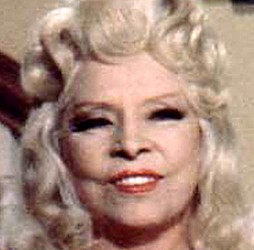
was the star of "Sextette," one of the last films
Rapper worked on.
RAPPER: You are now retired?
RAPPER: Hold on! I reverted to form, as dialogue director on "Sextertte" (1979). I started out as director, then saw it for an incoming disaster. From a great distance Mae (West) looks OK, but she was 86-ish at the time. When Mae sees the bodybuilders she says, “Wow! All this meat and no potatoes!” Was it funny that an octogenarian was still in heat? I wonder. Mae’s co-stars included Walter Pidgeon and Tony Curtis and George Raft and anybody else not working at the time. I suggested we all get afternoon sleeps. Mae just didn’t have the vigor to do it. She looked very old for the first time. I escaped intact. But why did Timothy Dalton do it, why? However he later was James Bond so it didn’t hurt his career.
BAWDEN: Who do you still see from the old days?
RAPPER: (George) Cukor who is remaking everybody else’s old classics. Not Bette, who hurt me with her AFI antics. George Brent, certainly. As long as she lived I was devoted to Ann Sheridan, the best Warners woman of them all. Chuck Heston keeps in touch. Paulette Goddard lives in one of those Swiss cantons. We are a rapidly disappearing breed. But if anybody wants me to direct a sequel to "Now, Voyager," I’d at least read the script.
Several years later, Rapper had “disappeared.” Turns out he had returned to New York city to be with relatives. He disappeared again, showing up at the Motion Picture Home in Woodland Hills in 1995. He had told me his goal was to live in three different centuries, but he died aged 101 on Dec. 20, 1999, just twelve days before achieving his great objective.
